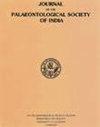Diatoms and Water Quality Indices in Thamirabarani River help Environmental Impact Assessment of stretch between Naranammalpuram and Punnakayal, Tamil Nadu, India
IF 0.6
4区 地球科学
Q4 PALEONTOLOGY
Journal of the Palaeontological Society of India
Pub Date : 2023-11-14
DOI:10.1177/05529360231209623
引用次数: 0
Abstract
The present study reports the occurrence of diatom taxa, their distribution and ecology in Thamirabarani River between the study areas Naranammalpuram and Punnakayal, covering the districts of Tirunelveli and Thoothukudiin Tamil Nadu, India. The study employs diatoms collected from 10 different locations in the Thamirabarani River to monitor its quality. A total of 40 diatom taxa belonging to 20 genera were recorded in the study area. The dominant presence of diatom taxa, such as Aulacoseira ambigua, Cocconeis placentula, Cyclotella meneghiniana, Cymbella tropica, Discostella stelligera, Gyrosigma acuminatum, Navicula cryptonella, Nitzschia amphibia, Planothidium lanceolatum, Staurosirella pinnata, and the water quality index values (29–48) recorded at sites 1 to 7 indicate oligotrophic due to good flow of water. The abundant of diatom taxa, such as Diadesmis confervacea, Gomphonema parvulum, Nitzschia palea and Pinnularia gibba, were recorded at sites 8–10, and the water quality indices (100–110) indicate eutrophication attributable to less flow of water, high dispersion of cremation ashes (the casting ceremony) and anthropogenic activities. Particularly, locations around Punnakayal are most polluted due to the dumping of fish wastes as well as stagnant water.印度泰米尔纳德邦纳拉纳马尔普兰至Punnakayal河段环境影响评价中,塔米拉巴拉尼河的硅藻和水质指数
本文报道了印度泰米尔纳德邦(Tamil Nadu)的Tirunelveli和thoothukudii地区,研究区Naranammalpuram和Punnakayal之间的Thamirabarani河硅藻类群的发生、分布和生态。这项研究使用了从塔米拉巴拉尼河10个不同地点收集的硅藻来监测其质量。研究区共记录到40个硅藻类群,隶属于20属。1 ~ 7点的水质指数值(29 ~ 48)显示,由于水体流动良好,水体营养不良,主要有双歧水藻、胎盘球藻、meneghiniana Cyclotella、热带银藻、星状盘藻、尖形盘藻、隐形盘藻、两栖Nitzschia、lanceolatum、Staurosirella;8 ~ 10个地点记录到丰富的硅藻类群,如白硅藻(Diadesmis convacea)、小苗硅藻(Gomphonema parvulum)、古硅藻(Nitzschia palea)和长毛针藻(Pinnularia gibba),水质指数(100 ~ 110)表明由于水量减少、骨灰(浇铸仪式)高度分散和人为活动导致水体富营养化。特别是,Punnakayal附近的地区污染最严重,因为倾倒鱼废料和死水。
本文章由计算机程序翻译,如有差异,请以英文原文为准。
求助全文
约1分钟内获得全文
求助全文
来源期刊

Journal of the Palaeontological Society of India
PALEONTOLOGY-
CiteScore
1.10
自引率
16.70%
发文量
0
期刊介绍:
The journal is devoted to the publication of original papers and review articles dealing with all aspects of Paleontology, Paleobotany, Stratigraphy, Geochronology, Anthropology and Pre-history.
 求助内容:
求助内容: 应助结果提醒方式:
应助结果提醒方式:


